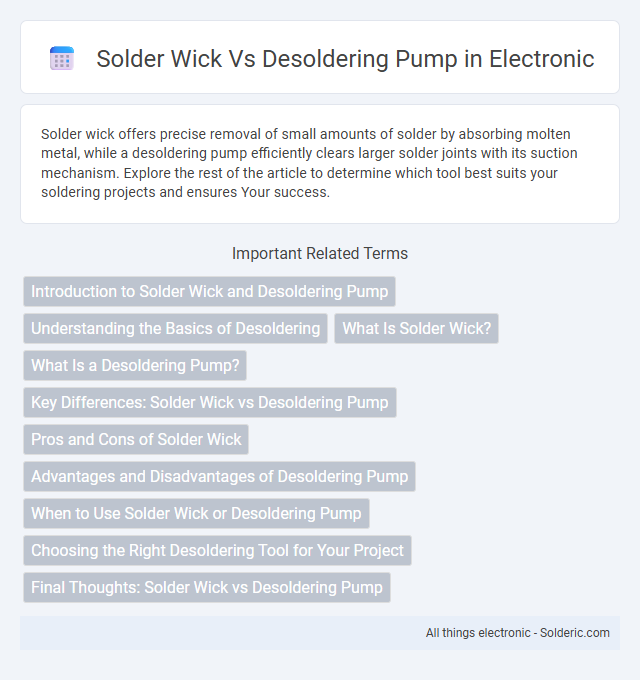Solder wick offers precise removal of small amounts of solder by absorbing molten metal, while a desoldering pump efficiently clears larger solder joints with its suction mechanism. Explore the rest of the article to determine which tool best suits your soldering projects and ensures Your success.
Comparison Table
| Feature | Solder Wick | Desoldering Pump |
|---|---|---|
| Purpose | Remove solder by absorption | Remove solder by suction |
| Usage | Place on solder, heat to absorb solder | Heat solder, activate pump to suction solder |
| Efficiency | Ideal for small areas and precise removal | Effective for larger amounts and quick removal |
| Cleanliness | Leaves no residue, clean finish | May leave solder residue inside pump |
| Reusability | Wick is consumable, replace after use | Pump is reusable, requires cleaning |
| Cost | Low-cost, consumable | Medium cost, durable tool |
| Portability | Small, lightweight | Bulky, requires maintenance |
| Best For | Precision solder removal on PCBs | Rapid solder removal on through-hole components |
Introduction to Solder Wick and Desoldering Pump
Solder wick and desoldering pumps are essential tools in electronics repair for removing unwanted solder from circuit boards. Solder wick, a fine braided copper wire, absorbs molten solder through capillary action, ideal for cleaning small areas and delicate components. Desoldering pumps, handheld vacuum devices, quickly suck up melted solder, making them suitable for clearing larger amounts of solder efficiently during repair or rework.
Understanding the Basics of Desoldering
Solder wick, made of fine braided copper wire, absorbs molten solder through capillary action, making it ideal for removing excess solder from small electronic components and tight spaces. Desoldering pumps, or solder suckers, use a vacuum mechanism to quickly suck up molten solder, providing efficient removal from through-hole pads and larger areas. Understanding these tools is essential for precise and clean desoldering in electronics repair and assembly.
What Is Solder Wick?
Solder wick, also known as desoldering braid, is a braided copper wire coated with flux designed to remove excess solder from circuit boards efficiently. It works by placing the braid on the solder joint and heating it with a soldering iron, allowing capillary action to draw the molten solder into the braid. Understanding solder wick helps you choose the right desoldering tool for precision work, especially in tight or delicate electronic assemblies.
What Is a Desoldering Pump?
A desoldering pump is a handheld tool designed to remove molten solder from circuit boards by creating a powerful vacuum to suck up the excess solder. It is commonly used in electronics repair and rework for precise and efficient desoldering of through-hole components. Compared to solder wick, which absorbs solder through capillary action, a desoldering pump offers quicker removal of larger amounts of solder.
Key Differences: Solder Wick vs Desoldering Pump
Solder wick removes excess solder by absorbing molten solder through capillary action, making it ideal for cleaning small, delicate components and achieving precise solder removal. Desoldering pumps use suction to quickly extract molten solder from larger joints or through-hole components, providing faster solder removal in bulkier applications. Key differences include the method of solder removal, precision level, and suitability for different component sizes and solder joint types.
Pros and Cons of Solder Wick
Solder wick offers precise control for removing excess solder from small components and tight spaces, minimizing the risk of damage to adjacent parts. It is reusable and works well for delicate electronics but can be slower compared to desoldering pumps and requires careful heating to avoid overheating the circuit board. Unlike desoldering pumps, solder wick may leave behind residue if not used properly, demanding thorough cleaning post-desoldering.
Advantages and Disadvantages of Desoldering Pump
The desoldering pump excels in quickly removing large amounts of molten solder from circuit boards, making it ideal for through-hole components and tight spaces. Its advantages include speed, ease of use, and reusability without the need for consumable materials, while disadvantages involve limited effectiveness on flat surfaces and small solder joints. Users may find that the pump's mechanical parts can wear out over time, reducing suction power and requiring occasional maintenance or replacement.
When to Use Solder Wick or Desoldering Pump
Solder wick is ideal for precision removal of small amounts of solder, especially in tight spaces or on delicate components where excess solder must be cleaned without disturbing adjacent parts. Desoldering pumps excel in quickly removing large solder blobs from through-hole components or when you need to clear a hole completely for component extraction. Your choice depends on the solder volume and component type, with solder wick suited for fine cleanup and desoldering pumps preferred for bulk solder removal.
Choosing the Right Desoldering Tool for Your Project
Choosing the right desoldering tool depends on the project's complexity and component type; solder wick excels in precision for small, delicate areas, while desoldering pumps are ideal for quickly removing larger amounts of solder. Solder wick uses braided copper to absorb molten solder, making it perfect for fine-pitch components and tight spaces. Desoldering pumps provide powerful suction to clear through-hole joints efficiently, speeding up the process on bulkier boards.
Final Thoughts: Solder Wick vs Desoldering Pump
Solder wick offers precise and clean removal of excess solder, making it ideal for delicate electronics and fine-pitch components, while desoldering pumps are faster for removing larger solder amounts on through-hole components. Both tools complement each other in efficient rework and repair processes, with solder wick excelling in detail and desoldering pumps providing speed. Choosing between them depends on the specific soldering task, component type, and desired cleanup quality.
solder wick vs desoldering pump Infographic

 solderic.com
solderic.com